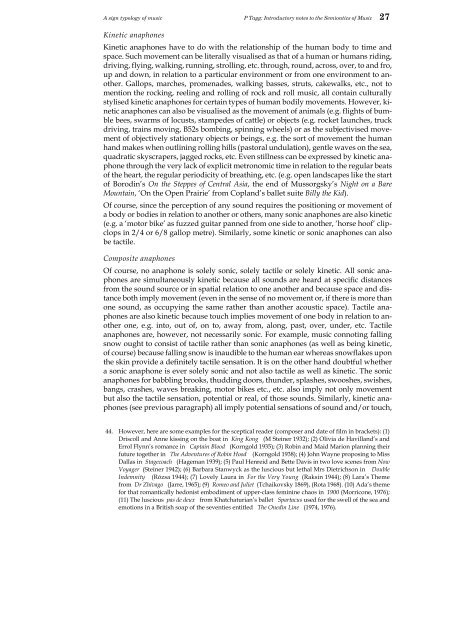Introductory notes to the Semiotics of Music - Philip Tagg's home page
Introductory notes to the Semiotics of Music - Philip Tagg's home page
Introductory notes to the Semiotics of Music - Philip Tagg's home page
Create successful ePaper yourself
Turn your PDF publications into a flip-book with our unique Google optimized e-Paper software.
A sign typology <strong>of</strong> music P Tagg: <strong>Introduc<strong>to</strong>ry</strong> <strong>notes</strong> <strong>to</strong> <strong>the</strong> Semiontics <strong>of</strong> <strong>Music</strong> 27<br />
Kinetic anaphones<br />
Kinetic anaphones have <strong>to</strong> do with <strong>the</strong> relationship <strong>of</strong> <strong>the</strong> human body <strong>to</strong> time and<br />
space. Such movement can be literally visualised as that <strong>of</strong> a human or humans riding,<br />
driving, flying, walking, running, strolling, etc. through, round, across, over, <strong>to</strong> and fro,<br />
up and down, in relation <strong>to</strong> a particular environment or from one environment <strong>to</strong> ano<strong>the</strong>r.<br />
Gallops, marches, promenades, walking basses, struts, cakewalks, etc., not <strong>to</strong><br />
mention <strong>the</strong> rocking, reeling and rolling <strong>of</strong> rock and roll music, all contain culturally<br />
stylised kinetic anaphones for certain types <strong>of</strong> human bodily movements. However, kinetic<br />
anaphones can also be visualised as <strong>the</strong> movement <strong>of</strong> animals (e.g. flights <strong>of</strong> bumble<br />
bees, swarms <strong>of</strong> locusts, stampedes <strong>of</strong> cattle) or objects (e.g. rocket launches, truck<br />
driving, trains moving, B52s bombing, spinning wheels) or as <strong>the</strong> subjectivised movement<br />
<strong>of</strong> objectively stationary objects or beings, e.g. <strong>the</strong> sort <strong>of</strong> movement <strong>the</strong> human<br />
hand makes when outlining rolling hills (pas<strong>to</strong>ral undulation), gentle waves on <strong>the</strong> sea,<br />
quadratic skyscrapers, jagged rocks, etc. Even stillness can be expressed by kinetic anaphone<br />
through <strong>the</strong> very lack <strong>of</strong> explicit metronomic time in relation <strong>to</strong> <strong>the</strong> regular beats<br />
<strong>of</strong> <strong>the</strong> heart, <strong>the</strong> regular periodicity <strong>of</strong> breathing, etc. (e.g. open landscapes like <strong>the</strong> start<br />
<strong>of</strong> Borodin’s On <strong>the</strong> Steppes <strong>of</strong> Central Asia, <strong>the</strong> end <strong>of</strong> Mussorgsky’s Night on a Bare<br />
Mountain, ‘On <strong>the</strong> Open Prairie’ from Copland’s ballet suite Billy <strong>the</strong> Kid).<br />
Of course, since <strong>the</strong> perception <strong>of</strong> any sound requires <strong>the</strong> positioning or movement <strong>of</strong><br />
a body or bodies in relation <strong>to</strong> ano<strong>the</strong>r or o<strong>the</strong>rs, many sonic anaphones are also kinetic<br />
(e.g. a ‘mo<strong>to</strong>r bike’ as fuzzed guitar panned from one side <strong>to</strong> ano<strong>the</strong>r, ‘horse ho<strong>of</strong>’ clipclops<br />
in 2/4 or 6/8 gallop metre). Similarly, some kinetic or sonic anaphones can also<br />
be tactile.<br />
Composite anaphones<br />
Of course, no anaphone is solely sonic, solely tactile or solely kinetic. All sonic anaphones<br />
are simultaneously kinetic because all sounds are heard at specific distances<br />
from <strong>the</strong> sound source or in spatial relation <strong>to</strong> one ano<strong>the</strong>r and because space and distance<br />
both imply movement (even in <strong>the</strong> sense <strong>of</strong> no movement or, if <strong>the</strong>re is more than<br />
one sound, as occupying <strong>the</strong> same ra<strong>the</strong>r than ano<strong>the</strong>r acoustic space). Tactile anaphones<br />
are also kinetic because <strong>to</strong>uch implies movement <strong>of</strong> one body in relation <strong>to</strong> ano<strong>the</strong>r<br />
one, e.g. in<strong>to</strong>, out <strong>of</strong>, on <strong>to</strong>, away from, along, past, over, under, etc. Tactile<br />
anaphones are, however, not necessarily sonic. For example, music connoting falling<br />
snow ought <strong>to</strong> consist <strong>of</strong> tactile ra<strong>the</strong>r than sonic anaphones (as well as being kinetic,<br />
<strong>of</strong> course) because falling snow is inaudible <strong>to</strong> <strong>the</strong> human ear whereas snowflakes upon<br />
<strong>the</strong> skin provide a definitely tactile sensation. It is on <strong>the</strong> o<strong>the</strong>r hand doubtful whe<strong>the</strong>r<br />
a sonic anaphone is ever solely sonic and not also tactile as well as kinetic. The sonic<br />
anaphones for babbling brooks, thudding doors, thunder, splashes, swooshes, swishes,<br />
bangs, crashes, waves breaking, mo<strong>to</strong>r bikes etc., etc. also imply not only movement<br />
but also <strong>the</strong> tactile sensation, potential or real, <strong>of</strong> those sounds. Similarly, kinetic anaphones<br />
(see previous paragraph) all imply potential sensations <strong>of</strong> sound and/or <strong>to</strong>uch,<br />
44. However, here are some examples for <strong>the</strong> sceptical reader (composer and date <strong>of</strong> film in brackets): (1)<br />
Driscoll and Anne kissing on <strong>the</strong> boat in King Kong (M Steiner 1932); (2) Olivia de Havilland’s and<br />
Errol Flynn’s romance in Captain Blood (Korngold 1935); (3) Robin and Maid Marion planning <strong>the</strong>ir<br />
future <strong>to</strong>ge<strong>the</strong>r in The Adventures <strong>of</strong> Robin Hood (Korngold 1938); (4) John Wayne proposing <strong>to</strong> Miss<br />
Dallas in Stagecoach (Hageman 1939); (5) Paul Henreid and Bette Davis in two love scenes from Now<br />
Voyager (Steiner 1942); (6) Barbara Stanwyck as <strong>the</strong> luscious but lethal Mrs Dietrichson in Double<br />
Indemnity (Rózsa 1944); (7) Lovely Laura in For <strong>the</strong> Very Young (Raksin 1944); (8) Lara’s Theme<br />
from Dr Zhivago (Jarre, 1965); (9) Romeo and Juliet (Tchaikovsky 1869), (Rota 1968). (10) Ada’s <strong>the</strong>me<br />
for that romantically hedonist embodiment <strong>of</strong> upper-class feminine chaos in 1900 (Morricone, 1976);<br />
(11) The luscious pas de deux from Khatchaturian’s ballet Spartacus used for <strong>the</strong> swell <strong>of</strong> <strong>the</strong> sea and<br />
emotions in a British soap <strong>of</strong> <strong>the</strong> seventies entitled The Onedin Line (1974, 1976).














